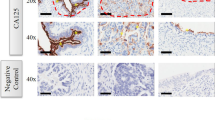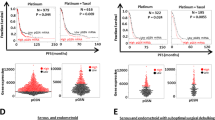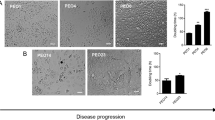Abstract
Overproduction of matrix metalloproteinases (MMPs) and alterations in adhesive and migratory behavior are common characteristics of metastatic cancer cells. Ovarian cancer is a highly invasive type of malignancy. The effect of the antineoplastic drug paclitaxel on human ovarian cancer cell (Ovcar-3) invasion was studied using an in vitro invasion assay with reconstituted basement membrane. The effect of treatment with paclitaxel was also determined separately on certain invasion-associated events, such as the secretion of 72 kDa type IV collagenase (gelatinase A/MMP-2), the expression of the tissue inhibitor of metalloproteinase-2 (TIMP-2), cell attachment and migration. Ovcar-3 cell attachment, migration and in vitro invasion were significantly decreased after paclitaxel treatment (P=0.02, P<0.01 and P=0.001, respectively) whereas no alteration in the secretion of latent MMP-2 was noted. However, the intracellular localization of the immunoreactive protein for MMP-2 was altered in response to paclitaxel treatment. Interestingly, paclitaxel increased the appearance of TIMP-2 protein in culture medium (P=0.002) but did not change the expression of mRNA for TIMP-2 in Ovcar-3 cells. These data show that paclitaxel is an effective suppressor of Ovcar-3 cell invasion. It inhibits attachment and migratory activities of the cells but also causes a release of TIMP-2 protein into the tissue culture medium.
Similar content being viewed by others
References
Schiff PB, Fant J and Horwitz SB, 1979, Promotion of microtubular assembly in vitroby taxol. Nature, 277, 655-67.
Einzig AI, Wiernik PH, Sasloff J, Runowicz CD and Goldberg GL, 1992, Phase II study and long-term follow-up of patients treated with taxol for advanced ovarian carcinoma. J Clin Oncol, 10, 1748-53.
McGuire WP, Rowinsky EK, Rosenshein NB, Grumbine FC, Ettinger DS, Armstrong EK and Donehower RC, 1989, Taxol: unique antineoplastic agent with significant activity in advanced ovarian epithelial neoplasms. Ann Int Med, 111, 273-79.
Thigpen T, Blessing J, Ball H, Hummel S and Barret R, 1990, Phase II trial of taxol as second-line therapy for ovarian carcinoma: a Gynecologic Oncology Group Study. Proc Am Assoc Clin Oncol, 10, 604.
Cottam DW and Rees RC, 1993, Regulation of matrix metalloproteinases: their role in tumor invasion and metastasis. Int J Oncol, 2, 861.
Khokha R and Denhardt DT, 1989, Matrix metalloproteinases and tissue inhibitor of metalloproteinases: a review of their role in tumorigenesis and tissue invasion. Invasion Metastasis, 9, 391-405.
Liotta LA, Steeg P and Stetler-Stevenson WG, 1991, Cancer metastasis and angiogenesis: an imbalance of positive and negative regulation. Cell, 64, 327-36.
Terranova VP, Hujanen ES, and Martin GK, 1986, Basement membrane and the invasive activity of metastatic tumor cells. J Natl Cancer Inst, 77, 311-16.
Liotta LA, Tryggvason K, Garbisa S, Hart I, Folts CM and Shafie S, 1980, Metastatic potential correlates with enzymatic degradation of basement membrane collagen. Nature, 284, 67-8.
Nakajima M, Welch D, Belloni PN and Nicolson GL, 1987, Degradation of basement membrane (type IV) collagen and lung subendothelial matrix by rat mammary adenocarcinoma cell clones of differing metastatic potentials. Cancer Res, 47, 4869-76.
Seftor EA, Seftor RE and Hendrix MJ, 1990, Selection of invasive and metastatic subpopulations from heterogeneous human melanoma cell line. Biotechniques, 9, 324-31.
Terranova VP, Hujanen ES, Loeb DM, Martin GR, Thornburg L and Glushko V, 1986, Use of a reconstituted basement membrane to measure cell invasiveness and select for highly invasive tumor cells. Proc Natl Acad Sci USA, 83, 465-9.
Thorgeirsson UP, Turpeenniemi-Hujanen T, Williams JE, Heilman CA, Talmadge JE and Liotta LA, 1985, NIH/3T3 cells transfected with human tumor DNA containing activated rasoncogenes express they metastatic phenotype in nude mice. Mol Cell Biol, 5, 259-62.
Tryggvason K, Huhtala P, Höyhtyä M, Hujanen E and Hurskainen T, 1992, 70k type IV collagenase (gelatinase). Matrix,Suppl, 1, 45-50.
Turpeenniemi-Hujanen T, Thorgeirsson UP, Hart IR, Grant SG and Liotta LA, 1985, Expression of collagenase IV (basement membrane collagenase) activity in murine tumor cell hybrids that differ in metastatic potential. J Natl Cancer Inst, 75, 99-103.
Ura H, Bonfil D, Teich R, Reddel R, Pfeirfer A, Harris CC and Klein-Szanto AJP, 1989, Expression of type IV collagenase and procollagen genes and its correlation with the tumorigenic, invasive and metastatic abilities of oncogene-transformed human bronchial epithelial cells. Cancer Res, 49, 4615-21.
Autio-Harmainen H, Karttunen T and Hurskainen T, 1993, Expression of 72 kDa type IV collagenase (gelatinase A) in benign and malignant ovarian tumors. Lab Invest, 63, 312-21.
Campo E, Merino MJ, Tavassoli FA, Charonis AS, Stetler-Stevenson WG and Liotta LA, 1992, Evaluation of basement membrane components and the 72 kDa type IV collagenase in serious tumors of the ovary. Am J Surg Pathol, 16, 500-7.
Höyhtyä M, Fridman R, Komarek D, Porter-Jordan K, Stetler-Stevenson WG, Liotta LA and Liang C-M, 1994, Immunohistochemical localization of matrix metalloproteinases 2 and its specific inhibitor TIMP-2 in neoplastic tissue with monoclonal antibodies. Int J Cancer, 56, 500-5.
Naylor MS, Stamp GW, Davies BD and Balkwill FR, 1994, Expression and activity of MMPs and their regulators in ovarian cancer. Int J Cancer, 58, 50-6.
Tryggvason K, Höyhtyä M and Pyke C, 1994, Type IV collagenase in invasive tumors. Breast Cancer Res Treat, 24, 209-18.
DeClerck YA, Perez N, Shimada H, Boone TC, Langley KE and Taylor SM, 1992, Inhibition of invasion and metastasis in cells transfected with an inhibitor of metalloproteinases. Cancer Res, 52, 701-8.
Kleiner DE Jr, Tuuttila A, Tryggvason K and Stetler-Stevenson WG, 1993, Stability analysis of latent and active 72-kDa type IV collagenase: the role of tissue inhibitor of metalloproteinases-2 (TIMP-2). Biochem, 32, 1583-92.
Ponton A, Coulombe B and Skup D, 1991, Decreased expression of tissue inhibitor of metalloproteinases in metastatic tumor cells leading to increased levels of collagenase activity. Cancer Res, 51, 2138-43.
Kleinman HK, McGarwey ML, Hassell JR, Star VL, Cannon FB, Laurie GW and Martin GR, 1986, Basement membrane complex with biological activity. Biochem, 28, 312-18.
Timpl R, Rohde H, Robey PG, Rennard SI, Foidart JM and Martin GR, 1979, A glycoprotein from basement membrane. J Biol Chem, 254, 9933-7.
Oi VT and Herzenberg LA, 1980, Immunglobulinproducing hybrid cell lines. In: Mishell BB and Shiigi SM, eds. Selected Methods in Cellular Immunology. San Francisco: Freeman, pp. 351-72.
Stetler-Stevenson WG, Krutzsch HC, Wacher MP, Margulies IMK and Liotta LA, 1989, The activation of human type IV collagenase proenzyme. Sequence identification of the major conversion product following organomercurial activation. J Biol Chem, 264, 1353-6.
Fridman R, Fuerst TR, Bird RE, Höyhyä M, Oelkuct M, Kraus S, Komarek D, Liotta LA, Berkan ML and Stetler-Stevenson WG, 1992, Domain structure of human 72-kDa gelatinase/type IV collagenase. Characterization of proteolytic activity and identification of the tissue inhibitor of metalloproteinase-2 (TIMP-2) binding regions. J Biol Chem, 267, 15398-405.
Heussen C and Dowdle ED, 1980, Electrophoretic analysis of plasminogen activators in polyacrylamide gels containing sodium dodecyl sulfate and copolymerized substrates. Anal Biochem, 102, 192-202.
Murphy G, Ward RC, Hembry RM, Reynolds JJ, Kühn K and Tryggvason K, 1989, Characterization of gelatinase from pig polymorphonuclear leucocytes. Biochem J, 258, 463-72.
Hujanen ES and Turpeenniemi-Hujanen, 1991, Recombinant interferon alpha and gamma modulate the invasive potential of human melanoma in vitro. Int J Cancer, 47, 576-81.
Klebe RJ, 1974, Isolation of a collagen-dependent cell attachment factor. Nature, 250, 248-51.
Hujanen E and Terranova VP, 1985, Migration of tumor cells to organ-derived chemoattractants. Cancer Res, 45, 3517-21.
Chomczynski P and Sacchi N, 1987, Single step method of RNA isolation by acid guanidium thiocyanate phenol chloroform extraction. Anal Biochem, 162, 156-9.
Devreotes PN and Zigmond SH, 1988, Chemotaxis in eukaryotic cells: a focus on leukocytes and Dictyostelium. Annu Rev Cell Biol, 4, 649-86.
Davies B, Brown PD, East N, Crimmin MJ and Balkwill FR, 1993, A synthetic matrix metalloproteinase inhibitor decreases tumor burden and prolongs survival of mice bearing human ovarian cancer xenografts. Cancer Res, 53, 2087-91.
Matrisian LM, 1990, Metalloproteinases and their inhibitors in matrix remodelling. Trends Genet, 6, 121-5.
Strongin AY, Collier I, Bannikov G, Marmer BL, Grant GA and Goldberg GI, 1995, Mechanism of cell surface activation of 72-kDa type IV collagenase. J Biol Chem, 270, 5331-8.
Monsky WL, Kelly T, Lin C-Y, Yeh Y, Stetler-Stevenson WG, Mueller SC and Chen W-T, 1993, Binding and localization of Mr 72,000 matrix metalloproteinase at cell surface invadopodia. Cancer Res, 53, 3159-64.
Hujanen ES, Väisänen A, Zheng A, Tryggvason K and Turpeenniemi-Hujanen T, 1994, Regulation of 72-kd and 92-kd type IV collagenase (gelatinase A and B) gene expression by interferon alpha and gamma in human melanoma. Int J Cancer, 58, 582-6.
Höyhtyä M, Hujanen ES, Turpeenniemi-Hujanen T, Thorgeirsson U, Liotta LA and Tryggvason K, 1990, Modulation of type IV collagenase activity and invasive behavior of metastatic human melanoma (A2058) cells in vitroby monoclonal antibodies to type IV collagenase. Int J Cancer, 46, 282-6.
Stearns ME and Wang M, 1992, Taxol blocks processes essential for prostate tumor cell (PC-2 ML) invasion and metastases. Cancer Res, 52, 3776-81.
Author information
Authors and Affiliations
Rights and permissions
About this article
Cite this article
Westerlund , A., Hujanen , E., Höyhtyä , M. et al. Ovarian cancer cell invasion is inhibited by paclitaxel. Clin Exp Metastasis 15, 318–328 (1997). https://doi.org/10.1023/A:1018481617275
Issue Date:
DOI: https://doi.org/10.1023/A:1018481617275




